

Compact Muon Solenoid
LHC, CERN
| CMS-PAS-HIN-16-017 | ||
| Charge asymmetry dependence of elliptic and triangular flow in pPb and PbPb collisions at √sNN= 5.02 TeV | ||
| CMS Collaboration | ||
| February 2017 | ||
| Abstract: Charge dependent elliptic azimuthal anisotropy (v2) in pPb and both v2 and triangular azimuthal anisotropy (v3) in PbPb collisions are measured at √sNN= 5.02 TeV with the CMS detector at the LHC. The normalized difference of v2 between positively and negatively charged particles, (v−2−v+2)/(v−2+v+2), shows a linear dependence with respect to the event-charged asymmetry Ach, with comparable slopes observed for pPb and PbPb collisions at similar multiplicities. In PbPb collisions, the slopes are found to be the same for the v2 and v3 coefficients within uncertainties. These observations pose a challenge to the hypothesis that the charge asymmetry dependence of v2 arises from a chiral magnetic wave. However, the results are in qualitative agreement with expectations based on local charge conservation. | ||
|
Links:
CDS record (PDF) ;
inSPIRE record ;
CADI line (restricted) ;
These preliminary results are superseded in this paper, PRC 100 (2019) 064908. The superseded preliminary plots can be found here. |
||
| Figures | |

png pdf |
Figure 1:
Elliptic flow v2 for positive- and negative-charged particles as a function of charge asymmetry (left) and the normalized v2 difference, (v−2−v+2)/(v−2+v+2), as a function of corrected event charge asymmetry (right) for multiplicity range 185 ≤Nofflinetrk< 220 in PbPb collisions at 5.02 TeV. Statistical uncertainties are indicated by the error bars. |

png pdf |
Figure 1-a:
Elliptic flow v2 for positive- and negative-charged particles as a function of charge asymmetry (left) and the normalized v2 difference, (v−2−v+2)/(v−2+v+2), as a function of corrected event charge asymmetry (right) for multiplicity range 185 ≤Nofflinetrk< 220 in pPb collisions at 5.02 TeV. Statistical uncertainties are indicated by the error bars. |

png pdf |
Figure 1-b:
Elliptic flow v2 for positive- and negative-charged particles as a function of charge asymmetry (left) and the normalized v2 difference, (v−2−v+2)/(v−2+v+2), as a function of corrected event charge asymmetry (right) for multiplicity range 185 ≤Nofflinetrk< 220 in PbPb collisions at 5.02 TeV. Statistical uncertainties are indicated by the error bars. |
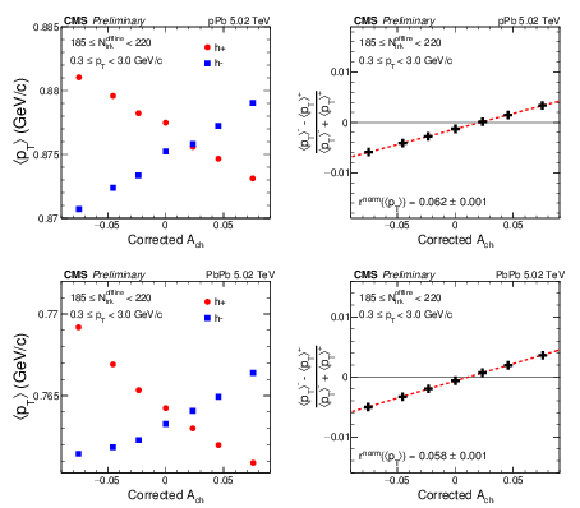
png pdf |
Figure 2:
The event-averaged pT value (<pT>) for positive- and negative-charged particles as a function of charge asymmetry (left) and the normalized <pT> difference, (<pT>−−<pT>+)/(<pT>−+<pT>+), as a function of corrected event charge asymmetry (right) for multiplicity range 185 ≤Nofflinetrk< 220 in pPb and PbPb collisions at 5.02 TeV. Statistical uncertainties are covered by the data points. |
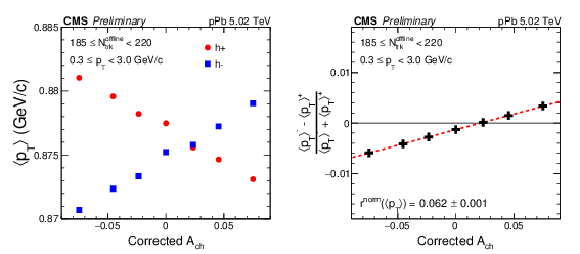
png pdf |
Figure 2-a:
The event-averaged pT value (<pT>) for positive- and negative-charged particles as a function of charge asymmetry (left) and the normalized <pT> difference, (<pT>−−<pT>+)/(<pT>−+<pT>+), as a function of corrected event charge asymmetry (right) for multiplicity range 185 ≤Nofflinetrk< 220 in pPb collisions at 5.02 TeV. Statistical uncertainties are covered by the data points. |
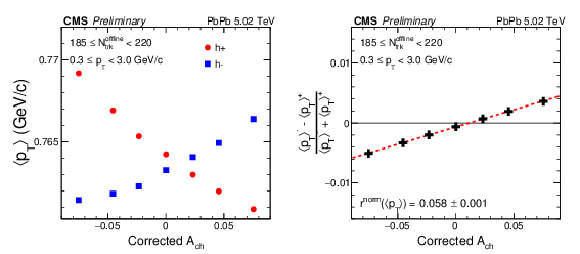
png pdf |
Figure 2-b:
The event-averaged pT value (<pT>) for positive- and negative-charged particles as a function of charge asymmetry (left) and the normalized <pT> difference, (<pT>−−<pT>+)/(<pT>−+<pT>+), as a function of corrected event charge asymmetry (right) for multiplicity range 185 ≤Nofflinetrk< 220 in PbPb collisions at 5.02 TeV. Statistical uncertainties are covered by the data points. |

png pdf |
Figure 3:
The linear slope for v2 (left) and <pT> (right) parameters rnorm2 and rnorm<pT> as a function of event multiplicity in pPb and PbPb collisions at √sNN= 5.02 TeV. Statistical and systematic uncertainties are indicated by the error bars and shaded regions, respectively. |
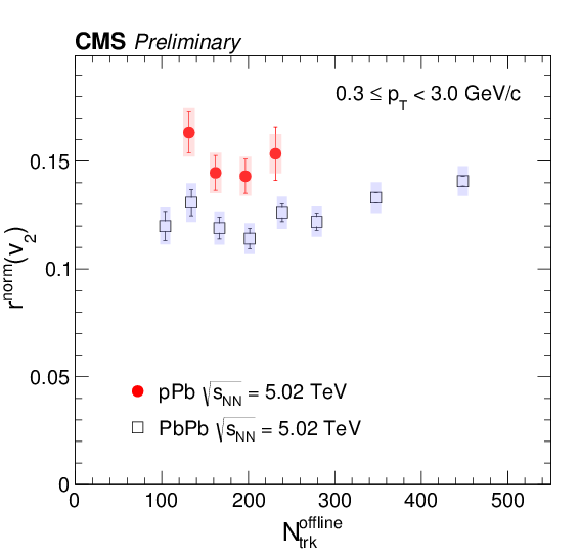
png pdf |
Figure 3-a:
The linear slope for v2 parameter rnorm2 as a function of event multiplicity in pPb and PbPb collisions at √sNN= 5.02 TeV. Statistical and systematic uncertainties are indicated by the error bars and shaded regions, respectively. |
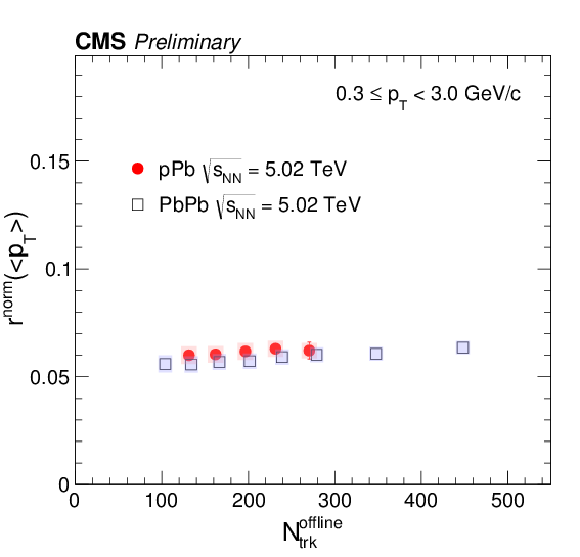
png pdf |
Figure 3-b:
The linear slope for <pT> parameter rnorm<pT> as a function of event multiplicity in pPb and PbPb collisions at √sNN= 5.02 TeV. Statistical and systematic uncertainties are indicated by the error bars and shaded regions, respectively. |
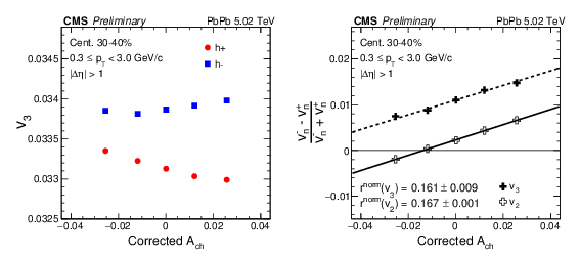
png pdf |
Figure 4:
The triangular flow v3 for positive- and negative-charged particles (left) and the normalized difference in vn, (v−n−v+n)/(v−n+v+n), for n= 2 and n= 3 (right) as a function of corrected event charge asymmetry for 30-40% centrality of PbPb collisions at √sNN= 5.02 TeV. Statistical uncertainties are covered by the data points. |
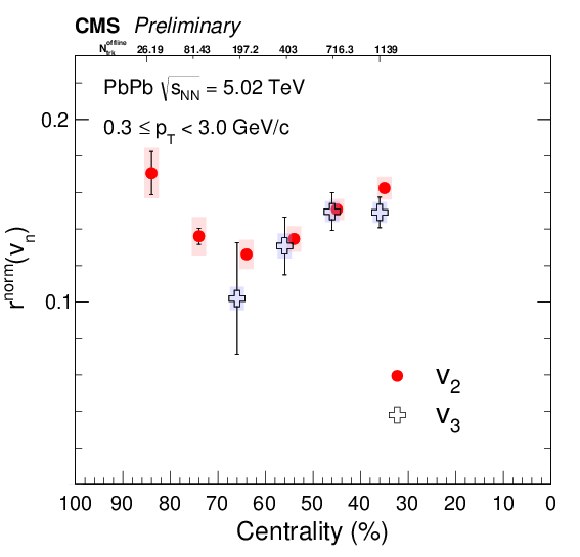
png pdf |
Figure 5:
The linear slope (rnormn) parameter for elliptic (n= 2) and triangular (n= 3) flow as a function of centrality for PbPb collisions at √sNN= 5.02 TeV. Statistical and systematic uncertainties are indicated by the error bars and shaded regions, respectively. |
| Summary |
| The charged-dependent elliptic flow coefficients (v2) in pPb and both v2 and triangular flow coefficients (v3) in PbPb have been measured as a function of event-charged asymmetry at √sNN= 5.02 TeV. The normalized slope parameters of v2 in pPb and PbPb collisions are found to be similar at the same event-charged particle multiplicities. Moreover, the normalized slope parameters of the v2 and v3 coefficients show similar magnitudes in various centralities. These observations would not be expected if the charge dependence resulted from a Chiral Magnetic Wave mechanism. The data are qualitatively consistent with predictions from the local charge conservation mechanism. |
| References | ||||
| 1 | T. D. Lee | A Theory of Spontaneous T Violation | PRD8 (1973) 1226--1239, .[,516(1973)] | |
| 2 | T. D. Lee and G. C. Wick | Vacuum Stability and Vacuum Excitation in a Spin 0 Field Theory | PRD9 (1974) 2291--2316 | |
| 3 | P. D. Morley and I. A. Schmidt | Strong P, CP, T violations in heavy-ion collisions | Zeitschrift f\"ur Physik C Particles and Fields 26 (1985) 627 | |
| 4 | D. Kharzeev, R. D. Pisarski, and M. H. G. Tytgat | Possibility of Spontaneous Parity Violation in Hot QCD | PRL 81 (1998) 512 | hep-ph/9804221 |
| 5 | D. Kharzeev | Parity violation in hot QCD: Why it can happen, and how to look for it | PLB 633 (2006) 260 | hep-ph/0406125 |
| 6 | D. E. Kharzeev, L. D. McLerran, and H. J. Warringa | The Effects of topological charge change in heavy ion collisions: 'Event by event P and CP violation' | Nucl. Phys. A 803 (2008) 227--253 | 0711.0950 |
| 7 | D. E. Kharzeev, J. Liao, S. A. Voloshin, and G. Wang | Chiral magnetic and vortical effects in high-energy nuclear collisions—A status report | Prog. Part. Nucl. Phys. 88 (2016) 1--28 | 1511.04050 |
| 8 | Y. Burnier, D. E. Kharzeev, J. Liao, and H.-U. Yee | Chiral magnetic wave at finite baryon density and the electric quadrupole moment of quark-gluon plasma in heavy ion collisions | PRL 107 (2011) 052303 | 1103.1307 |
| 9 | G. M. Newman | Anomalous hydrodynamics | JHEP 01 (2006) 158 | hep-ph/0511236 |
| 10 | E. V. Gorbar, V. A. Miransky, and I. A. Shovkovy | Normal ground state of dense relativistic matter in a magnetic field | PRD 83 (2011) 085003 | 1101.4954 |
| 11 | ALICE Collaboration | Charge separation relative to the reaction plane in Pb-Pb collisions at √sNN= 2.76 TeV | PRL 110 (2013) 012301 | 1207.0900 |
| 12 | STAR Collaboration | Observation of charge asymmetry dependence of pion elliptic flow and the possible chiral magnetic wave in heavy-ion collisions | PRL 114 (2015) 252302 | 1504.02175 |
| 13 | ALICE Collaboration | Charge-dependent flow and the search for the chiral magnetic wave in Pb-Pb collisions at √sNN= 2.76 TeV | PRC 93 (2016) 044903 | 1512.05739 |
| 14 | A. Bzdak and P. Bozek | Contributions to the event-by-event charge asymmetry dependence for the elliptic flow of pi+ and pi− in heavy-ion collisions | PLB 726 (2013) 239 | 1303.1138 |
| 15 | CMS Collaboration | Observation of Long-Range Near-Side Angular Correlations in Proton-Proton Collisions at the LHC | JHEP 09 (2010) 091 | CMS-QCD-10-002 1009.4122 |
| 16 | ATLAS Collaboration | Observation of Long-Range Elliptic Azimuthal Anisotropies in √s= 13 and 2.76 TeV pp Collisions with the ATLAS Detector | PRL 116 (2016) 172301 | 1509.04776 |
| 17 | CMS Collaboration | Measurement of Long-Range Near-Side Two-Particle Angular Correlations in pp collisions at √s= 13 TeV | PRL 116 (2016) 172302 | CMS-FSQ-15-002 1510.03068 |
| 18 | CMS Collaboration | Evidence for collectivity in pp collisions at the LHC | Submitted to PLB | CMS-HIN-16-010 1606.06198 |
| 19 | CMS Collaboration | Observation of long-range near-side angular correlations in proton-lead collisions at the LHC | PLB 718 (2013) 795 | CMS-HIN-12-015 1210.5482 |
| 20 | ALICE Collaboration | Long-range angular correlations on the near and away side in pPb collisions at √sNN= 5.02 TeV | PLB 719 (2013) 29 | 1212.2001 |
| 21 | ATLAS Collaboration | Observation of associated near-side and away-side long-range correlations in √sNN= 5.02 TeV proton-lead collisions with the ATLAS detector | PRL 110 (2013) 182302 | 1212.5198 |
| 22 | LHCb Collaboration | Measurements of long-range near-side angular correlations in √sNN= 5 TeV proton-lead collisions in the forward region | 1512.00439 | |
| 23 | CMS Collaboration | Long-range two-particle correlations of strange hadrons with charged particles in pPb and PbPb collisions at LHC energies | PLB 742 (2015) 200 | CMS-HIN-14-002 1409.3392 |
| 24 | ALICE Collaboration | Long-range angular correlations of π, K and p in p--Pb collisions at √sNN= 5.02 TeV | PLB 726 (2013) 164 | 1307.3237 |
| 25 | CMS Collaboration | Multiplicity and transverse momentum dependence of two- and four-particle correlations in pPb and $PbPb collisions | PLB 724 (2013) 213 | CMS-HIN-13-002 1305.0609 |
| 26 | ATLAS Collaboration | Measurement of long-range pseudorapidity correlations and azimuthal harmonics in √sNN= 5.02 TeV proton-lead collisions with the ATLAS detector | PRC 90 (2014) 044906 | 1409.1792 |
| 27 | CMS Collaboration | Evidence for Collective Multiparticle Correlations in p-Pb Collisions | PRL 115 (2015) 012301 | CMS-HIN-14-006 1502.05382 |
| 28 | K. Dusling, W. Li, and B. Schenke | Novel collective phenomena in high-energy proton-proton and proton-nucleus collisions | Int. J. Mod. Phys. E 25 (2016) 1630002 | 1509.07939 |
| 29 | CMS Collaboration | Observation of charge-dependent azimuthal correlations in pPb collisions and its implication for the search for the chiral magnetic effect | CMS-HIN-16-009 1610.00263 |
|
| 30 | CMS Collaboration | Description and performance of track and primary-vertex reconstruction with the CMS tracker | JINST 9 (2014) P10009 | CMS-TRK-11-001 1405.6569 |
| 31 | CMS Collaboration | The CMS experiment at the CERN LHC | JINST 3 (2008) S08004 | CMS-00-001 |
| 32 | T. Pierog et al. | EPOS LHC : test of collective hadronization with LHC data | 1306.0121 | |
| 33 | M. Gyulassy and X.-N. Wang | HIJING 1.0: A Monte Carlo program for parton and particle production in high-energy hadronic and nuclear collisions | CPC 83 (1994) 307 | nucl-th/9502021 |
| 34 | I. P. Lokhtin et al. | Heavy ion event generator HYDJET++ (HYDrodynamics plus JETs) | CPC 180 (2009) 779 | 0809.2708 |
| 35 | A. Bilandzic, R. Snellings, and S. Voloshin | Flow analysis with cumulants: Direct calculations | Phys.Rev. C83 (2011) 044913 | 1010.0233 |

|
Compact Muon Solenoid LHC, CERN |

|

|

|

|

|

|